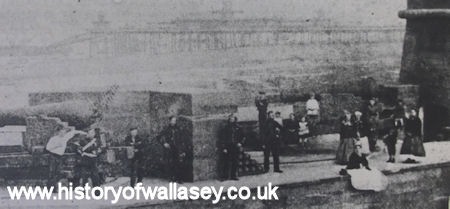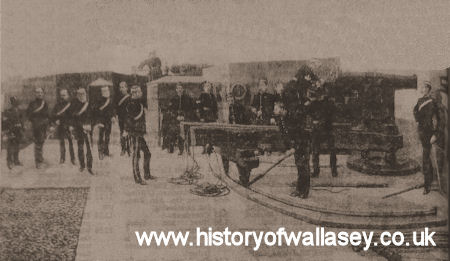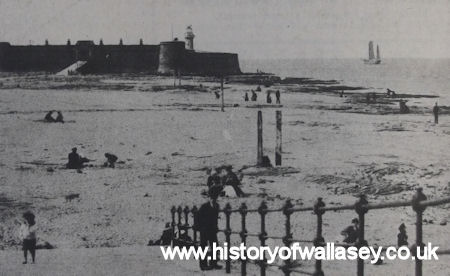Perch Rock at New Brighton is the fort that never really went to war. The seaway sentinel that only fired in earnest twice – and then at friends. The massive pile that became a War Office ‘unwanted’. The baby battery that both Liverpool and Wallasey did not want to take under their wing. The ‘Little Gibraltar’ that ended up as a trippers’ playground with a cafe where the cannons used to be.
The idea of the fort was born during the wars against Napoleon. A few years before the Battle of Trafalgar, the Port of Liverpool feared the possibility of attack from French ships.
But there were squabbles about the division of building costs, and plans were not put into execution until 1826.
The battery was designed by John Sikes Kitson, a Royal Engineers officer. It was completed in 1829.
It cost £27,000. It looked powerfully strong on its great outcrop of rock.
At that time all shipping entered the harbour through the Rock Channel, and the guns of the fort were trained to bear in that direction.
There were originally 18 guns. Sixteen of them were 12-pounders. They were mounted on cast iron traversing platforms. There were furnaces for heating shot.
 |
A rare photograph of the guns inside Fort Perch Rock taken in the 1880s. Lady visitors are seen sitting on the old walls. The original pier is in the background. |
Inside the fort was accommodation for one hundred men. There were officers’ quarters and kitchens.
With its tremendous walls. 32 feet thick on the river side, 15 feet thick where they faced the land, it could have withstood a siege.
But the guns boomed only twice in wartime. They spat in anger by mistake.
Soon after the declaration of war in August 1914, a Norwegian sailing ship ignored signals from the fort to heave to. The C.O., Major Charles Luya, a Wallasey dentist, ordered a shot to be fired across here bows.
The gun had too much elevation. The shell sailed over the ship. It landed in the sandhills at Hightown.
The ship still sailed on, and a second attempt was made with the gun elevation corrected.
Trouble gain! Shell No.2 hit a vessel lying at anchor.
When the Norwegian ship was intercepted and the master asked for an explanation, he said he did not know that war had been declared.
Asked why he had not heaved to on hearing the shot, he replied, “I think you only make play!”
There is no record of what the fort’s C.O replied to that. Faces were red. Embarrassment was acute.
An irate householder over in Hightown recovered the first shot from the sandhills near his home and carried it in a bucket to the headquarters of the Merseyside Defence.
He indignantly demanded an explanation. There is no record of what he was told.
At the time of all that the medical officer of the fort was a Dr. J.W. Lloyd, father of Mr. Selwyn Lloyd.
History repeated itself after the declaration of World War Two, in 1939.
Early in September of that year a fishing smack in full sail was spotted entering the port by the way of the Rock Channel, which was closed to all shipping for the duration of the war.
When the small craft was about a mile and a half away a warning shot was fired some two hundred yards in front of her.
 |
The 15th Lancashire Volunteer Artillery at gun practice in Perch Rock Battery. In 1878 the corps was raised and commanded by Colonel John Mewburn. |
Her crew were seen making frantic signals to prove that they were not hostile.
The smack was apprehended at New Brighton Pier. It was the same old story.
The skipper explained that having been at sea since the start of the war he was a bit behind in his news. He was unaware of the emergency regulations concerning entry into the port.
During the war years the military were in occupation. There were sentries on guard.
The inquisitive were kept away. There was a local rumour that secret work was taking place within the massive walls.
The fort was camouflaged as a tea garden. The top was painted green to resemble grass, and ‘paths’ were painted across the ‘grass’.
On the roof of one of the buildings there was a great white sign. ‘Teas’ it said to aircraft passing overhead.
It is hard to believe that any enemy bomber would have been seriously deceived, but the military were satisfied with their little disguise, and the fort was never touched.
 |
The sands and the fort at New Brighton photographed round about the time of the World War One. |
Early in 1957 the War Office offered Fort Perch Rock to Liverpool. Liverpool rejected it.
In November of the same year it was offered to Wallasey. Wallasey said “No, thank you.”
In June, 1958, it was put up for auction. The sale in Liverpool got itself a lot of publicity.
There was talk of making it an anglers’ hotel. It was suggested it might become a night club.
It was sold for £4,000 – with vacant possession. Two business men became its new ‘C.O’.
Today it is owned by the Darroch family and houses a cafe and amusements as well as a maritime and aviation museum.
Stripped of its guns, its ammunition and its armour, the Little Gibraltar off New Brighton, has become a trippers’ place.
The only invasion it was to ever know was the summer day invasion of coach parties.
But see it on a winter night, when winds whip high tides into heavy waves, when there is a roar in the weather, and it looks what it was meant to be. A brooding hulk. A salt water drenched watchdog with power hidden in its massive ribs.
Featured sites
- Non Gamstop Casinos
- Casino Not On Gamstop
- UK Casinos Not On Gamstop
- Non Gamstop Casinos UK
- Sites Not On Gamstop
- Sites Not On Gamstop
- Casinos Not On Gamstop
- Casinos Not On Gamstop
- Casinos Not On Gamstop
- Non Gamstop Casino UK
- Casinos Not On Gamstop
- Non Gamstop Casino
- UK Online Casinos Not On Gamstop
- UK Online Casinos Not On Gamstop
- Non Gamstop Casinos
- Casino Sites Not On Gamstop
- Casinos Not On Gamstop
- Casinos Not On Gamstop
- Best Betting Sites
- Casinos Not On Gamstop
- Gambling Sites Not On Gamstop
- Betting Sites That Are Not On Gamstop
- Non Gamstop Casinos UK
- UK Online Casinos Not On Gamstop